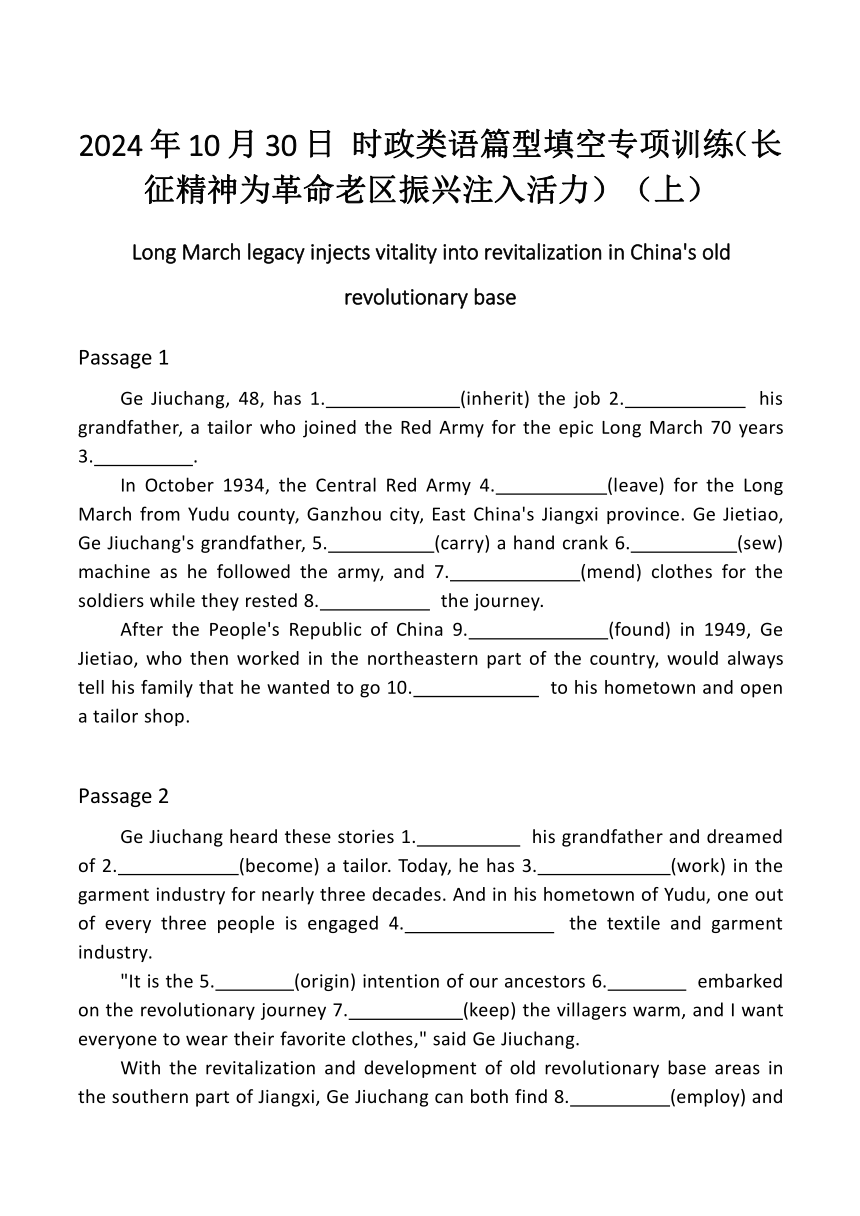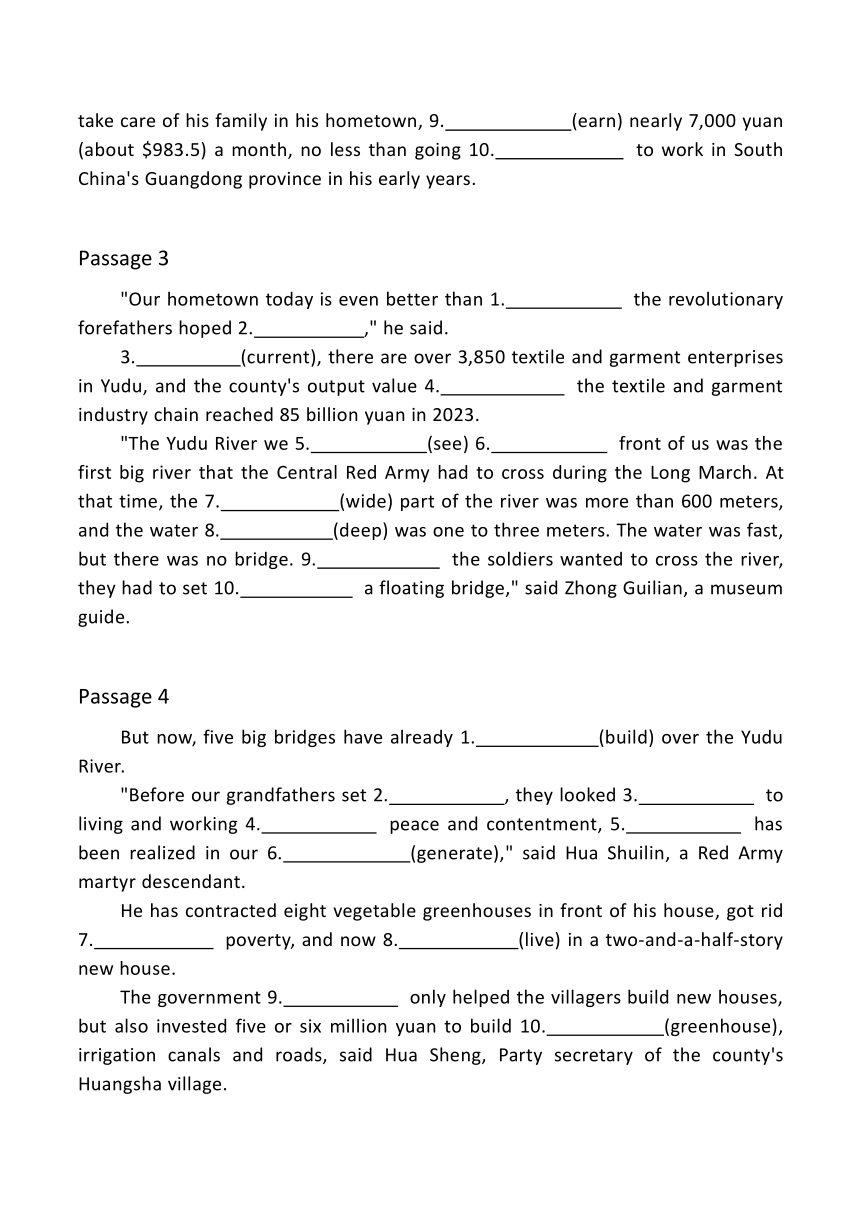2024年10月30日 时政类语篇型填空专项训练(长征精神为革命老区振兴注入活力)(上)(4篇,含答案与译文)-2025届高三英语复习专项
文档属性
| 名称 | 2024年10月30日 时政类语篇型填空专项训练(长征精神为革命老区振兴注入活力)(上)(4篇,含答案与译文)-2025届高三英语复习专项 |  | |
| 格式 | docx | ||
| 文件大小 | 26.9KB | ||
| 资源类型 | 教案 | ||
| 版本资源 | 人教版(2019) | ||
| 科目 | 英语 | ||
| 更新时间 | 2025-01-19 15:04:22 | ||
图片预览


文档简介
2024年10月30日 时政类语篇型填空专项训练(长征精神为革命老区振兴注入活力)(上)
Long March legacy injects vitality into revitalization in China's old revolutionary base
Passage 1
Ge Jiuchang, 48, has 1. (inherit) the job 2. his grandfather, a tailor who joined the Red Army for the epic Long March 70 years 3. .
In October 1934, the Central Red Army 4. (leave) for the Long March from Yudu county, Ganzhou city, East China's Jiangxi province. Ge Jietiao, Ge Jiuchang's grandfather, 5. (carry) a hand crank 6. (sew) machine as he followed the army, and 7. (mend) clothes for the soldiers while they rested 8. the journey.
After the People's Republic of China 9. (found) in 1949, Ge Jietiao, who then worked in the northeastern part of the country, would always tell his family that he wanted to go 10. to his hometown and open a tailor shop.
Passage 2
Ge Jiuchang heard these stories 1. his grandfather and dreamed of 2. (become) a tailor. Today, he has 3. (work) in the garment industry for nearly three decades. And in his hometown of Yudu, one out of every three people is engaged 4. the textile and garment industry.
"It is the 5. (origin) intention of our ancestors 6. embarked on the revolutionary journey 7. (keep) the villagers warm, and I want everyone to wear their favorite clothes," said Ge Jiuchang.
With the revitalization and development of old revolutionary base areas in the southern part of Jiangxi, Ge Jiuchang can both find 8. (employ) and take care of his family in his hometown, 9. (earn) nearly 7,000 yuan (about $983.5) a month, no less than going 10. to work in South China's Guangdong province in his early years.
Passage 3
"Our hometown today is even better than 1. the revolutionary forefathers hoped 2. ," he said.
3. (current), there are over 3,850 textile and garment enterprises in Yudu, and the county's output value 4. the textile and garment industry chain reached 85 billion yuan in 2023.
"The Yudu River we 5. (see) 6. front of us was the first big river that the Central Red Army had to cross during the Long March. At that time, the 7. (wide) part of the river was more than 600 meters, and the water 8. (deep) was one to three meters. The water was fast, but there was no bridge. 9. the soldiers wanted to cross the river, they had to set 10. a floating bridge," said Zhong Guilian, a museum guide.
Passage 4
But now, five big bridges have already 1. (build) over the Yudu River.
"Before our grandfathers set 2. , they looked 3. to living and working 4. peace and contentment, 5. has been realized in our 6. (generate)," said Hua Shuilin, a Red Army martyr descendant.
He has contracted eight vegetable greenhouses in front of his house, got rid 7. poverty, and now 8. (live) in a two-and-a-half-story new house.
The government 9. only helped the villagers build new houses, but also invested five or six million yuan to build 10. (greenhouse), irrigation canals and roads, said Hua Sheng, Party secretary of the county's Huangsha village.
参考答案
参考答案1
1.inherited 2.of 3.ago 4.left 5.carried
6.sewing 7.mended 8.during 9.was founded 10.back
参考译文1
48岁的葛久昌继承了祖父的工作,祖父是一名裁缝,70年前参加了史诗般的长征红军。
1934年10月,中央红军从中国东部江西省赣州市虞都县出发,开始长征。葛九长的祖父葛节条带着一台手摇缝纫机跟随军队,在士兵休息的时候给他们缝补衣服。
1949年中华人民共和国成立后,当时在东北地区工作的葛洁条总是告诉家人,他想回家乡开一家裁缝店。
参考答案2
1.about 2.becoming 3.been working 4.in 5.original
6.who 7.to keep 8.employment 9.earning 10.out
参考译文2
葛久昌听了爷爷的这些故事,梦想成为一名裁缝。如今,他已经在服装行业工作了近30年。在他的家乡玉都,每三个人中就有一个从事纺织服装行业。
葛久昌说:“为村民保暖是我们先辈踏上革命征程的初衷,我希望每个人都能穿上自己喜欢的衣服。”
随着赣南革命老区的振兴和发展,葛久昌在家乡既能找到工作,又能照顾家人,每月收入近7000元(约合983.5美元),不低于他早年在中国南方广东省工作的收入。
参考答案3
1.what 2.for 3.Currently 4.of 5.saw
6.in 7.widest 8.depth 9.If 10.up
参考译文3
他说:“今天我们的家乡比革命先辈所希望的还要好。”
目前,玉都有纺织服装企业3850多家,到2023年,玉都纺织服装产业链总产值达到850亿元。
“我们眼前看到的玉渡河,是中央红军长征必经的第一条大河。当时,这条河最宽的地方有600多米,水深一到三米。水流湍急,但没有桥。如果士兵们想过河,他们必须架起一座浮桥,”博物馆导游钟桂莲(音译)说。
参考答案4
1.been built 2.off 3.forward 4.in 5.which
6.generation 7.of 8.lives 9.not 10.greenhouses
参考译文4
但现在,五座大桥已经在玉渡河上建成。
红军烈士后代华水林说:“在我们的祖辈出发之前,他们期待着安居乐业,这在我们这一代已经实现了。”
他承包了家门口的8个蔬菜大棚,摆脱了贫困,现在住在一幢两层半的新房子里。
该县黄沙村党委书记盛华说,政府不仅帮助村民盖了新房子,还投资了五六百万元修建温室、灌溉渠和道路。
Long March legacy injects vitality into revitalization in China's old revolutionary base
Passage 1
Ge Jiuchang, 48, has 1. (inherit) the job 2. his grandfather, a tailor who joined the Red Army for the epic Long March 70 years 3. .
In October 1934, the Central Red Army 4. (leave) for the Long March from Yudu county, Ganzhou city, East China's Jiangxi province. Ge Jietiao, Ge Jiuchang's grandfather, 5. (carry) a hand crank 6. (sew) machine as he followed the army, and 7. (mend) clothes for the soldiers while they rested 8. the journey.
After the People's Republic of China 9. (found) in 1949, Ge Jietiao, who then worked in the northeastern part of the country, would always tell his family that he wanted to go 10. to his hometown and open a tailor shop.
Passage 2
Ge Jiuchang heard these stories 1. his grandfather and dreamed of 2. (become) a tailor. Today, he has 3. (work) in the garment industry for nearly three decades. And in his hometown of Yudu, one out of every three people is engaged 4. the textile and garment industry.
"It is the 5. (origin) intention of our ancestors 6. embarked on the revolutionary journey 7. (keep) the villagers warm, and I want everyone to wear their favorite clothes," said Ge Jiuchang.
With the revitalization and development of old revolutionary base areas in the southern part of Jiangxi, Ge Jiuchang can both find 8. (employ) and take care of his family in his hometown, 9. (earn) nearly 7,000 yuan (about $983.5) a month, no less than going 10. to work in South China's Guangdong province in his early years.
Passage 3
"Our hometown today is even better than 1. the revolutionary forefathers hoped 2. ," he said.
3. (current), there are over 3,850 textile and garment enterprises in Yudu, and the county's output value 4. the textile and garment industry chain reached 85 billion yuan in 2023.
"The Yudu River we 5. (see) 6. front of us was the first big river that the Central Red Army had to cross during the Long March. At that time, the 7. (wide) part of the river was more than 600 meters, and the water 8. (deep) was one to three meters. The water was fast, but there was no bridge. 9. the soldiers wanted to cross the river, they had to set 10. a floating bridge," said Zhong Guilian, a museum guide.
Passage 4
But now, five big bridges have already 1. (build) over the Yudu River.
"Before our grandfathers set 2. , they looked 3. to living and working 4. peace and contentment, 5. has been realized in our 6. (generate)," said Hua Shuilin, a Red Army martyr descendant.
He has contracted eight vegetable greenhouses in front of his house, got rid 7. poverty, and now 8. (live) in a two-and-a-half-story new house.
The government 9. only helped the villagers build new houses, but also invested five or six million yuan to build 10. (greenhouse), irrigation canals and roads, said Hua Sheng, Party secretary of the county's Huangsha village.
参考答案
参考答案1
1.inherited 2.of 3.ago 4.left 5.carried
6.sewing 7.mended 8.during 9.was founded 10.back
参考译文1
48岁的葛久昌继承了祖父的工作,祖父是一名裁缝,70年前参加了史诗般的长征红军。
1934年10月,中央红军从中国东部江西省赣州市虞都县出发,开始长征。葛九长的祖父葛节条带着一台手摇缝纫机跟随军队,在士兵休息的时候给他们缝补衣服。
1949年中华人民共和国成立后,当时在东北地区工作的葛洁条总是告诉家人,他想回家乡开一家裁缝店。
参考答案2
1.about 2.becoming 3.been working 4.in 5.original
6.who 7.to keep 8.employment 9.earning 10.out
参考译文2
葛久昌听了爷爷的这些故事,梦想成为一名裁缝。如今,他已经在服装行业工作了近30年。在他的家乡玉都,每三个人中就有一个从事纺织服装行业。
葛久昌说:“为村民保暖是我们先辈踏上革命征程的初衷,我希望每个人都能穿上自己喜欢的衣服。”
随着赣南革命老区的振兴和发展,葛久昌在家乡既能找到工作,又能照顾家人,每月收入近7000元(约合983.5美元),不低于他早年在中国南方广东省工作的收入。
参考答案3
1.what 2.for 3.Currently 4.of 5.saw
6.in 7.widest 8.depth 9.If 10.up
参考译文3
他说:“今天我们的家乡比革命先辈所希望的还要好。”
目前,玉都有纺织服装企业3850多家,到2023年,玉都纺织服装产业链总产值达到850亿元。
“我们眼前看到的玉渡河,是中央红军长征必经的第一条大河。当时,这条河最宽的地方有600多米,水深一到三米。水流湍急,但没有桥。如果士兵们想过河,他们必须架起一座浮桥,”博物馆导游钟桂莲(音译)说。
参考答案4
1.been built 2.off 3.forward 4.in 5.which
6.generation 7.of 8.lives 9.not 10.greenhouses
参考译文4
但现在,五座大桥已经在玉渡河上建成。
红军烈士后代华水林说:“在我们的祖辈出发之前,他们期待着安居乐业,这在我们这一代已经实现了。”
他承包了家门口的8个蔬菜大棚,摆脱了贫困,现在住在一幢两层半的新房子里。
该县黄沙村党委书记盛华说,政府不仅帮助村民盖了新房子,还投资了五六百万元修建温室、灌溉渠和道路。
